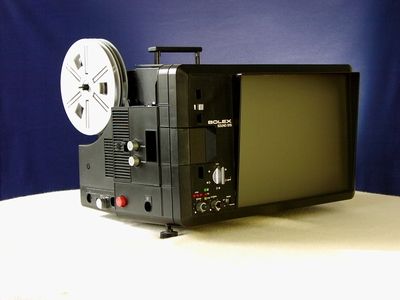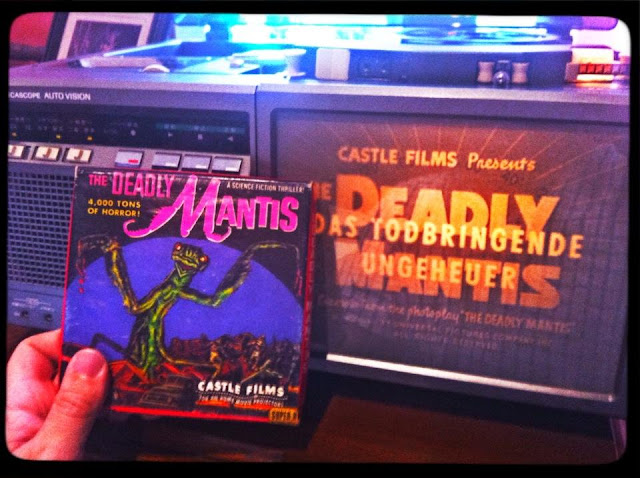During the "golden age" of Super-8, Bauer Silma, Eumig, Elmo, Bolex, Chinon, Fujifilm and other manufacturers sold "buit-in" rear projection machines, silent and with sound. In this post of the blog, we will only deal with sound versions.
 |
| SC-8T: industrial use |
The revolution would come a few years later, in 1976. from the hand of Eumig, first with silent built-in machines and, shortly after, already with sound.
It is worth mentioning here that the built-in screen projector for the Polavision cinema system, from Polaroid, was also built in those years by Eumig.
 |
| Eumig RS3000: a best seller in Spain. |
The first built-in screen sound projector to reach the market was the Eumig RS 3000 High Quality Sound, with a 334 x 300 mm screen. The popularization of this kind of rear screen projectors with sound for domestic use, at an affordable price, was possible in Europe thanks to the Austrian firm Eumig that in 1978 sold its RS 3000 High Quality Sound model in Spain as hot cakes. Exactly the same machine, with a few cosmetic changes, was also distributed under the Bolex brand, as Bolex Sound 815
Shortly after, Robert Bosch also presented his range of built-in screen projectors, with the Bauer TR100, 200 and 300, built in Italy at the Silma factory (in those years, owned by Bosch), with a screen of 224 x 300 mm. For many decades, I have owned the Bauer TR300 that can read both soundtracks. It has not only one, but two rear projection screens (one, very small, to, in theory, sound the movies). Bauer built-in screen projectors were also sold under the Silma brand, painted in heavenly white!
 |
| TR300: this machine was many year in my office |
Both the Eumig / Bolex and the Bauer / Silma, although they are well built, and offer very good sound quality, lack a fundamental element, the upper feed toothed roller: it is the claw itself that pulls the film, from its feed spool.
Other with built-in screen with rear projector is the Chinon DS, with a 220 x 300 mm screen, available in 3 versions: black, brown and with piano-key type control, but my opinion about the Chinon products is very bad.
A cheap but very well done built-in screen device, twin track, is the Elmo SC18 but the screen is only moderated, of 150 x 110 mm. Inside, the same projector of the model Elmo ST180, so, a very reliable machine.
The SC30 should not be confused with its younger brother the SC18. The SC30 offers a larger (156 x 220 mm), higher-quality built-in screen, as well as being fully automatic: just feed the film through the slot and the machine does everything on its own, from turning on the lamp to turning off at the end of the run.
It is one of the few Super-8 projectors that also have an electronic remote control that even incorporates a microphone!I used the microphone on the remote a lot when my children were young to record their narrations superimposed on the original sound of magnetic stripe while they watched the movie on the small screen.
It is also the brightest projector with a built-in screen, of those described in this article, as it uses the 150 lamp instead of the 100 W lamp, like all the others.
ELMO SC 30: A MAGNIFICENT REAR-PROJECTION MACHINE.
Although it can project on a large screen, with its famous f 1.1 zoom lens (one of the sharpest ever made) and its 150W lamp, I normally use the SC30 as it was conceived: for rear projection, with the two units I own, one in the HAL9000 room at IB Cinema and another in my bedroom at home.
THE UNKNOW PROJECTOR: THE FUJICASCOPE AUTOVISION.
In 1980, and during 3 years, the Fujicascope SD Auto was the leader market of sound super 8 projectors in Spain. Moderately priced, the machine was fully automatic. The Fujicascope SD Auto was, as all the Fujicascope projectors built from 1975, manufactured by Yamawa, a joint venture between Fuji Film and the Japanese division of the Xerox in Japan. The projectors built in Yamawa factory were sold with the Fujifilm brand in Japan, Fujicascope, but in other markets were sold by many other names: Bell & Howell, Porst, Yashica, even Noris, and also with the own brand of Yelco.
In those times, I was an student of journalism living in Barcelona and I regularly wrote test reports about S8 mm gear for the Spanish magazine “Cinema 2002”. In 1981, I was given by the then Fujifilm agents in Spain, Mampel Asens, one of this Fujicascope Autovision to check it. They payed me to write an inform about the commercial possibilities of this projector in Spain.
The Fujicascope Autovision is a sound projector that projects either in a small built-in screen, which is approximately 150 x 200 mm, or, by opening a swing open lateral little door, onto an external front-projection screen in normal way. Differently of other similar sound projectors of the period, that looks like convencional super 8 projectors with a built-in screen, the Fujicascope Autovision looks like an old videocassette recorder.
As in the early 80s the video was round the corner, and the thinking of the men should to go to new medium, according to the marketing experts in Fujifilm, the AutoVision was designed as an easy fully automatic projector for the women, to match with the Fuji P100 Sound camera or the little P2. As in the SD Auto, this machine is fully automatic: you only need to introduce the film in the projector and the its start to work alone: the motor starts to works, switch on the lamp, the loop –if necessary- is redone automatically; and the projector stops without help when the film is end. Incluso you don´t need a take up reel. This projector was thinked to be in one table of the living room.
Despiste the price should be so low as possible the machine is twin track magnetic and the optical sound is a standard feature. A curiosity of the Autovision is that it does not have a take-up reel: the film is collected inside the projector, and is automatically rewound. After check the projector, I sent my written verdict to Fujifilm Spain: the commercial success of this machine in Spain could be a fiasco. I was told than the report of a technician in Germany had the same verdict, so, the Autovision never was sold out of Japan. Only two units came to Europe and I was given one of them by Fujifilm Spain. Still with me, after this decades, now in my living room!, to watch super-8 movies with the family meanwhile we dinner.
 |
| Bolex 815, a clone of Eumig RS3000 |
CONCLUSION. In case you need a projector with a built-in screen, my recommendation is the Elmo SC30. For a home living room, then, the Fujicascope Autovision. If low price is a fundamental condition, but at the same time you need a quality machine, in that case the Elmo SC18.








Where Can Buy BENQ 300 Projector in Uae, BENQ LED WXGA Projector in Uae, BENQ Portable Projector in Uae
ResponderEliminarhttps://gccgamers.com/monitors-projectors/portable-projectors/benq-300-led-wxga-portable-projector-for-outdoor-family-gs1.html